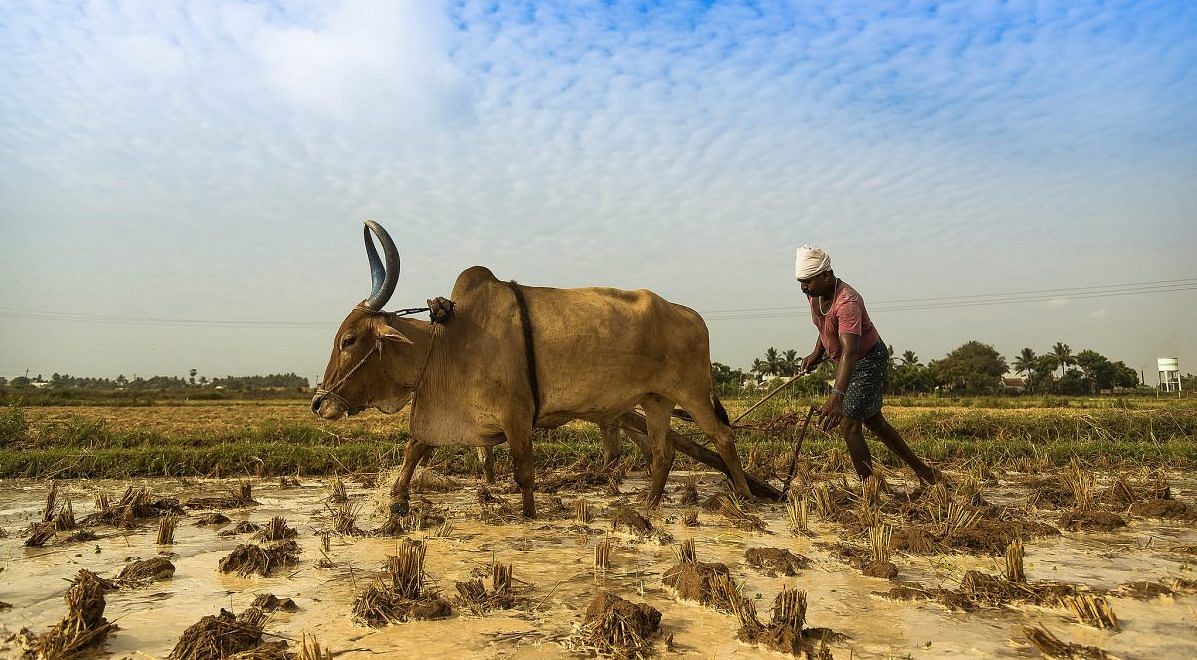In the realm of agriculture, financing serves as the bedrock of success, facilitating the growth and prosperity of farming operations. Access to capital is the lifeblood of the agricultural landscape, allowing for the acquisition of essential resources like land, machinery, labor, and inputs. It’s this financial support that empowers farmers to navigate the seasonal ebbs and flows, ensuring the sustenance of day-to-day operations throughout the year. This article serves as your guiding light through the complexities of agricultural financing, imparting insights that will empower you to make well-informed decisions for a flourishing future.

Read more.. How Much Is Renters Insurance? 2023 Rates
What is an Agricultural Loan
An agricultural loan is a financial instrument designed to meet the diverse needs of individuals and entities involved in agricultural activities. These loans are extended to farmers, agribusinesses, cooperatives, and others involved in the agriculture sector to support their operations, investments, and growth.
Agricultural loans provide farmers and agricultural businesses with access to the capital necessary for various purposes, such as purchasing land, livestock, machinery, seeds, fertilizers, and other essential resources. They can also help in meeting day-to-day operational expenses, expanding operations, and improving overall farm productivity.

Read more.. Best Pet Insurance For Pre-Existing Conditions
Agricultural Finance: Cultivating Prosperity for Farmers
Agriculture finance is a cornerstone of support for farmers, playing a pivotal role in nurturing their livelihoods and ensuring the success of farming operations. This financial assistance is predominantly provided by banks and commercial sectors, extending a helping hand to those who toil the soil to feed nations. Farmers can access agricultural loans to acquire essential equipment, sustain day-to-day expenses, and empower their agricultural pursuits. The spectrum of agricultural finance encompasses a wide array of needs, such as digging and tube wells, agricultural implements, seeds, livestock, marketing of agricultural produce, well repairs, fertilizers, land improvements, manures, labor payments, and more.
Agricultural finance delves into the intricate financial aspects of the farm business, often referred to as the core sector of India. This financial scrutiny encompasses the monetary aspects associated with agricultural production and the subsequent management of agricultural products.
Defining Agricultural Finance
To comprehensively understand agricultural finance, it is imperative to explore multiple definitions. Two notable definitions shed light on the intricacies of this financial sector.
- Murray (1953) described agricultural finance as “a financial analysis of borrowing funds and reserves by farmers, the operation of farm lending agencies, association, and of organization interest in loans for agriculture.”
- Tandon and Dhondyal (1962) specified that agricultural finance is “an associate of agricultural economics, which deals with financial or economic resources connected to individual farm divisions.

The Imperative Need for Agricultural Finance
In contemporary times, the need for agricultural finance has grown exponentially. Farmers rely on these financial aids to fulfill their production requirements, purchase essential farming equipment, and ensure a bountiful harvest. Additionally, agricultural finance plays a pivotal role in addressing various needs, such as agricultural marketing, post-harvesting storage, transportation of produce, ensuring a consistent power supply, acquiring high-quality seeds, procuring fertilizers, mitigating risks associated with pests and diseases, countering the challenges posed by low rainfall, and ensuring protection against potential damage.

Agricultural finance, thus, serves as the bedrock of agricultural success, empowering farmers to navigate the challenges of their profession. In the ever-evolving agricultural landscape, access to financial resources is vital to sustain and advance this vital sector of the economy.
Crop insurance is an essential component of modern agricultural practices, offering a safety net for farmers who face the unpredictable nature of crop yields and the harsh realities of nature’s fury. Recent news has highlighted the extreme measures taken by farmers when faced with the instability of crop production, making it evident that the need for crop insurance is more significant than ever.
There are compelling reasons why crop insurance is a fundamental requirement that every farmer should consider:
Stabilizing Farm Incomes: Crop insurance acts as a buffer, especially during years when disasters strike. This stabilization of farm incomes is vital for the financial sustainability of farmers who depend on agriculture for their livelihoods.
Protection from Natural Calamities: In the face of natural calamities, diseases, and pest outbreaks, crop insurance offers farmers a financial safety net. It ensures that they can recover from the devastation, helping them avoid falling into a cycle of debt and poverty.
Promoting Progressive Farming: Crop insurance acts as an incentive for farmers to embrace progressive farming practices and incorporate advanced agricultural technologies. It encourages them to invest in technology and better methods to protect their crops.
The features and benefits of crop insurance are manifold:
Financial Support in Crop Failure:
Crop insurance provides financial assistance when crops fail due to unforeseen circumstances. This financial cushion is essential in nurturing and sustaining crop production.
Promoting Advanced Farming Practices:
The insurance fosters the adoption of modern and advanced farming techniques, ensuring a sustainable and prosperous future for agriculture.
Maintaining Agricultural Credit Flow:
It helps maintain the flow of credit in agriculture by providing a secure backdrop for both farmers and lending institutions.
Economic Growth and Community Welfare:
Crop insurance’s benefits extend beyond individual farmers. The entire community enjoys direct and indirect advantages, including the continuity of production, sustained employment, tax revenues, and market fees. The overall economic growth of a region can also be significantly affected by the presence of crop insurance.
Loss Assessment and Data Collection:
Crop insurance programs streamline the loss assessment process, helping to build an accurate statistical database for crop production. This data can be invaluable for research, policy-making, and future planning.
In terms of coverage, crop insurance has evolved over the years, ensuring that farmers receive comprehensive protection. The scope of coverage varies depending on the insurance policies selected by farmers. Here’s a breakdown of what’s typically covered and what’s not:
Covered:
- Loss or damage to the property of the insured farmer.
- Damage or loss due to fire or natural disasters, such as storms, floods, tornadoes, earthquakes, and cyclones.
- Coverage for personal accidents, including the insured farmer and family members.
- Cover for the loss of essential equipment, such as pump sets and tractors.
- Protection against damage or loss caused by power failures.
Not Covered:
- Damage or loss due to negligence, improper care, or lack of maintenance.
- Damage caused by wars, civil unrest, or nuclear accidents.
- Non-crop-related losses.
Numerous general insurance companies provide crop insurance, including:
1. Reliance General Insurance Co. Ltd.
2. Cholamandalam MS General Insurance Co. Ltd.
3. Agriculture Insurance Company of India Ltd.
4. IFFCO-Tokio General Insurance Co. Ltd.
5. HDFC ERGO General Insurance Co. Ltd.
6. ICICI Lombard General Insurance Co. Ltd.
7. Future Generali India Insurance Company Limited
8. Bajaj Allianz General Insurance Co. Ltd.
9. Universal Sompo General Insurance Company Limited
10. SBI General Insurance Company Limited
Compare Best Agriculture Loan Interest Rates in India
| Name of the Bank | Interest Rate | Processing Fee |
| Central Bank of India (Cent Kisan Tatkal Scheme) | 8.70% p.a. onwards | |
| IndusInd Bank (Crop Loan) | 10.15% – 14.75% p.a. | Up to 1% plus service tax |
| HDFC Bank (Retail Agri Loans) | 9.10% – 20.00% p.a. | 2% to 4% or Rs.2,500 |
| Federal Bank (Federal Green Plus Loan Scheme) | 11.60% p.a. | As per the lender’s terms and conditions |
| Union Bank of India (Land Purchase Loan) | 8.70% p.a. onwards | Up to Rs.25,000 – Nil |
| Karur Vysya Bank (Green Harvester) | 10.30% p.a. | As per the lender’s terms and conditions |
| Canara Bank (Kisan Suvidha Scheme) | 10.10% p.a. | As per the lender’s terms and conditions |
| Andhra Bank (AB Kisan Rakshak) | 13.00% p.a. | As per the lender’s terms and conditions |
| UCO Bank (UCO Kisan Bhoomi Vridhi) | 3.10% – 3.50% p.a. | Nil up to Rs.3 lakh |
Types of Agricultural Loans
Agricultural loans encompass a range of financing options, each tailored to address specific agricultural needs. Here are some common types of agricultural loans:
1. Farm Ownership Loans:
These loans are intended to assist farmers in acquiring farmland or making significant improvements to existing land. They can be used for purchasing land, constructing or repairing farm structures, and making permanent infrastructure enhancements.
2. Operating Loans:
Operating loans provide short-term financial assistance to cover day-to-day farming expenses such as seed, fertilizer, labor, and other operational costs. These loans are essential to bridge gaps in cash flow and ensure smooth farming operations.
3. Equipment Loans:
Farmers often require specialized machinery and equipment to enhance productivity and efficiency. Equipment loans are designed to finance the purchase of tractors, plows, harvesters, and other necessary tools.
4. Livestock Loans:
These loans are focused on assisting farmers in acquiring or expanding their livestock operations. They can be used for purchasing cattle, poultry, swine, and other animals.
5. Crop Production Loans:
Crop production loans are essential for financing the planting, growing, and harvesting of crops. These loans can cover expenses related to purchasing seeds, fertilizers, pesticides, and labor.
6. Agribusiness Loans:
Agribusiness loans are directed towards entities involved in processing, marketing, and distribution of agricultural products. They support businesses engaged in food processing, agri-export, and more.
7. Rural Development Loans:
These loans aim to promote rural development by providing funds for infrastructure projects, community facilities, and other initiatives that benefit rural areas.
8. Agri-Real Estate Loans:
Agri-real estate loans are tailored for purchasing and developing agricultural property. They are instrumental in expanding or enhancing the value of agricultural land.
9. Warehouse Receipt Financing:
This type of financing is specific to crop storage. Farmers can use their harvested crops as collateral to obtain loans, and the crops are stored in accredited warehouses.
10. Seasonal Loans:
Seasonal loans are short-term credits granted to farmers to meet seasonal expenses associated with planting and harvesting. These loans help in managing the cyclical nature of agriculture.
11. Term Loans:
Term loans are generally used for long-term projects and investments in agriculture, such as setting up agribusinesses, building infrastructure, or making capital improvements.
12. Bridge Loans:
Bridge loans serve as interim financing, typically used when the permanent source of funding is not available. They help farmers bridge the financial gap until long-term financing is secured.
13. Farm Service Agency (FSA) Loans:
FSA loans are backed by the U.S. Department of Agriculture (USDA) and support a wide range of agricultural activities, including farm ownership, operations, and emergency assistance.
14. Conservation Loans:
These loans aim to encourage conservation practices and the adoption of sustainable farming techniques. They can assist in implementing eco-friendly initiatives on the farm.
Each of these agricultural loan types serves a specific purpose within the farming and agribusiness realm, addressing the unique financial requirements of individuals and entities involved in agriculture. Understanding these options is essential for farmers and agricultural stakeholders looking to secure the right financing to support their endeavors, achieve growth, and ensure the sustainability of their operations.
Frequently Asked Questions
9.1. What are the prevalent challenges in agricultural financing?
The world of agricultural financing presents unique challenges due to factors such as unpredictable weather, market fluctuations, and the dynamic nature of technologies. An understanding of these challenges is vital for success.
9.2. How do interest rates impact the profitability of farming?
Interest rates hold the key to the cost of borrowing for agricultural purposes. Higher rates can erode profits, while lower rates can be advantageous for farmers.
9.3. Why is crop insurance crucial for farmers?
Crop insurance acts as a financial safety net for farmers, ensuring they do not suffer crippling financial losses due to factors beyond their control, such as droughts or floods.
9.4. How can I enhance my credit score to secure better interest rates on agricultural loans?
Elevating your credit score necessitates timely repayments, the reduction of outstanding debts, and the prudent management of your finances.
9.5. What are the steps for applying for an agricultural loan?
To apply for an agricultural loan, you generally need to provide financial records, a well-structured business plan, and collateral. Thorough research to select the right lender tailored to your specific needs is imperative.







